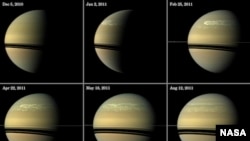The U.S. space agency NASA says a super storm on Saturn offered a rare glimpse into the planet’s thick inner atmosphere, revealing “the first detection at Saturn of water ice.”
According to a new paper, the water ice was churned up from deep inside the planet’s atmosphere by a huge storm that was first spotted in 2010. Evidence of water ice was detected by NASA's Cassini spacecraft using near-infrared measurements.
"The new finding from Cassini shows that Saturn can dredge up material from more than 160 kilometers," said Kevin Baines, a co-author of the paper, who works at the University of Wisconsin-Madison and NASA's Jet Propulsion Laboratory in Pasadena, California. "It demonstrates in a very real sense that typically demure-looking Saturn can be just as explosive or even more so than typically stormy Jupiter."
Saturn’s atmosphere is believed to be made up of a layer of water clouds at the bottom, ammonia hydrosulfide in the middle and ammonia clouds at the top. Those layers are just below an upper tropospheric haze of unknown composition that obscures almost everything, according to scientists.
The storm, which tears across the northern hemisphere of the massive planet once every 30 years, appears to have disrupted those layers, churning up water vapor that condensed and froze as it rose.
“We think this huge thunderstorm is driving these cloud particles upward, sort of like a volcano bringing up material from the depths and making it visible from outside the atmosphere,” said Lawrence Sromovsky of the University of Wisconsin, who led the researchers. “The upper haze is so optically thick that it is only in the stormy regions where the haze is penetrated by powerful updrafts that you can see evidence for the ammonia ice and the water ice. Those storm particles have an infrared color signature that is very different from the haze particles in the surrounding atmosphere.”
The dynamics are not that different from thunderstorms on Earth, where air and water vapor are pushed up high into the atmosphere, where they form towering, billowing clouds. The storm on Saturn is believed to cover an expanse of up to 300,000 kilometers with winds of 500 kilometers per hour.
According to a new paper, the water ice was churned up from deep inside the planet’s atmosphere by a huge storm that was first spotted in 2010. Evidence of water ice was detected by NASA's Cassini spacecraft using near-infrared measurements.
"The new finding from Cassini shows that Saturn can dredge up material from more than 160 kilometers," said Kevin Baines, a co-author of the paper, who works at the University of Wisconsin-Madison and NASA's Jet Propulsion Laboratory in Pasadena, California. "It demonstrates in a very real sense that typically demure-looking Saturn can be just as explosive or even more so than typically stormy Jupiter."
Saturn’s atmosphere is believed to be made up of a layer of water clouds at the bottom, ammonia hydrosulfide in the middle and ammonia clouds at the top. Those layers are just below an upper tropospheric haze of unknown composition that obscures almost everything, according to scientists.
The storm, which tears across the northern hemisphere of the massive planet once every 30 years, appears to have disrupted those layers, churning up water vapor that condensed and froze as it rose.
“We think this huge thunderstorm is driving these cloud particles upward, sort of like a volcano bringing up material from the depths and making it visible from outside the atmosphere,” said Lawrence Sromovsky of the University of Wisconsin, who led the researchers. “The upper haze is so optically thick that it is only in the stormy regions where the haze is penetrated by powerful updrafts that you can see evidence for the ammonia ice and the water ice. Those storm particles have an infrared color signature that is very different from the haze particles in the surrounding atmosphere.”
The dynamics are not that different from thunderstorms on Earth, where air and water vapor are pushed up high into the atmosphere, where they form towering, billowing clouds. The storm on Saturn is believed to cover an expanse of up to 300,000 kilometers with winds of 500 kilometers per hour.









